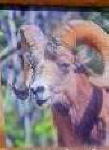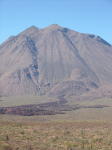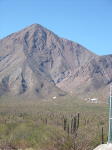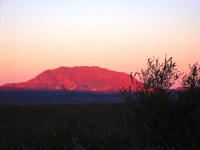Eleven of us from Posada Concepción, south of Mulegé, drove up to Las Tres Vírgenes,
a geothermal area just east of Highway 1 between Santa Rosalia and San Ignacio. Our intention was to
arrive sometime in the afternoon of December 28th, 2010 and stay one night at the hunting lodge, some
sleeping in the cabañas, others in their campers. On the second day we would hope to see bighorn sheep,
walk, see volcanic stuff and whatever was available. My husband and I arrived around noon. Oscar, the
first man to greet us, was in a little of a panic because the staff had no idea when we were to arrive
that day, they had been anticipating us all morning. My fault. Alfredo, the absent main guide, had asked me via
email when we would come, but I thought he meant dates, not time. It makes sense now.
The first thing Oscar did, though, was offer us coffee and lunch. Our group had agreed to come
self-sufficient, so we didn't take him up on lunch, but enjoyed the good coffee. While we were discussing
our communication problems, another of our group drove straight up the main road, so Oscar gave me a
Gatorade and said, "get in" (into his truck) and we drove after him. Not a problem, it's just that the
staff are really concerned about our safety. "We are responsible," Oscar kept saying. By the time we
caught up with our renegade, another truck (the patrolling white pickup from the geothermal plant) had already started pursuing him
to the gate (about 8 miles in from the Highway 1). We had him cornered and he laughingly confessed. What we were to learn was that the staff
have permission to take us anywhere in the ejido, but they are responsible for us, so all we have to do
is ASK. By the way, we were told that the electricity from the plant powers the area from San Ignacio to
Santa Rosalia (maybe even Mulegé?). There are 100 employees that work for the geothermal plant. Some
work in offices in Santa Rosalia, but most work either first or second shift. The pipelines running along
the road carry steam from the plant that condenses and flows into catchments. The water from these
catchments are recycled into the plant.
The Ejido Alfredo V. Bonfil is defined by land boundaries and by membership. The land is vast: from San Francisquito to
San Ignacio (including Santa Marta and Sierra San Francisco), past Mulegé to Playa El Coyote. The
area is 519,000 hectares, the membership is 142. These members work for the benefit of the land and its
population. Someone may be able to explain the ejido structure in more detail.
The rest of our band came in over the next couple hours. Meanwhile, we were helped with our gear to move
into our cabañas, make our beds, you name it. Oscar made a point of learning everyone's name and
introducing us to José, a ranger I believe, Élias, the treasurer, and Juan, who has been here
for 15 years. Once everyone was settled in, whether inside or in their campers, we took a 2 hour stroll
out to the lava flow (3 miles return). It was a chance to stretch our legs and view the vegetation and
animal tracks: cattle, deer, mule, fox, rabbits. A nice view of "El Barco" (Ship Rock) was afforded to us.
The trees were typical to the area, but only the copalquín grew on the old lava flow. Plenty of cholla to
dance around as well.
Back at the lodge with the huge kitchen, it was after 5pm and our group took over heating up all the
prepared pots of soups, beans, rice and more. We were spending so much time looking over the "trophies"
and reading about them, while slurping away, that we missed the best part of sunset. Oscar, whose main
job was to translate, had Jose tell us about tomorrow's activities. We discussed the possibilities and
decided to leave at 8am after coffee (at 7am) and breakfast, then try to find the bighorn sheep, walk
the canyon, view the fumaroles and see more of the area around the geothermal plant. By 8pm all were
heading to their sleeping stations. Oh, and we were supplied electricity for lighting our rooms from
6pm till 10pm and then again in the morning while we got our acts together.
In the morning, Alfredo, our contact, and others appeared. Alfredo, Oscar and José would be our guides for the
day, but others came along to help spot animals. Then 10 of the 11 (one had a bad tummy) jumped into
vehicles, some in their own, others in the ejido's and departed on schedule. We were escorted past the
gate to around Km 15 of the main road and climbed up to the viewing platform to look for sheep. The high-power binoculars
were required to spot the animals almost a kilometer away on the other side of the canyon. Some of us got
to see one bighorn and some got to see a deer.
When the patience dwindled, we drove a little farther to the trailhead and descended into the canyon.
Now, most of our group have not done much canyon walking this season, so this was not another walk on
the beach. Our guides informed us that before the 1959 floods, there used to be a road through the canyon
to a rancho. (I got the impression the rancho may still be there, but we never saw it.) A little later we
were told that before Hurricane Jimena brought down the rocks all along the canyon walls, the walk along the wash
was very pleasant. Our trek required stepping up and over many landslides, but there were nice sections
of wash and tufa to soften our footsteps. Some of our party started to get too stressed, one finally quit
only minutes from our destination (after some ibuprofen and rest, she was fine). The rest of us endured to
reach the thermal springs and rock art.
Compared with the beautiful canyon, this was an anticlimax, but still interesting. LUNCH. The return was
quicker, taking only 1.5 hours instead of 2.5. The length of the walk was 5 miles in and out. There were
places to stop to examine geology, like the seashells imbedded in the floor and ceiling of a cave. The
story goes that when the Baja Peninsula separated from the Mainland, there was an upthrust of the Peninsula
and the seafloor can now be seen in this canyon among other places. I must make a disclaimer that I am
giving my impressions of what was said, not what is the truth.
Back at the vehicles we carried on to the end of the road (Km 17+), where there was some more geothermal
machinery, we clambered over rocks to view fumaroles or steam vents. There is a small viewing platform
here and the only place we smelled sulfur.
We stopped on the way back to camp to try again to view sheep. One did appear, but only showed its wide,
white back end, no profile; however, its horns were enormous, if that's what I saw.
We're pooped. Time to pay up and drive home. We thanked everyone smilingly because it was a successful
trip.
Now for more details and a little perspective. The lodge area was initially built up to care for the
licensed hunters. There are 6 or 7 permits granted each year. In 1994, 90 sheep were counted. Now 450
exist. Only the rams are shot, which are normally 8-10 years old, mainly because of the size of the
trophy. Each hunter comes to hunt for 10 days, sometime between the end of November and late
March. He is guided all over to view his perspective target and when he chooses his sheep he shoots it
(at around 300 yards). Saying that, one can begin to understand the attention the guides and staff give
to their clients and wildlife. However, there is a shift to more tourism, but it's in its infancy.
We got our initial information by quizzing
Baja Nomads.
BajaBlanca provided us with photos and contact information. b1 added
more photos -- scroll down the page.
I then contacted Alfredo as to reserving 2 rooms for 1 night and a tour the second day. We got partial
answers to a lot of our questions. This is what we learned in the end.
-- Getting to the lodge, for lack of a better word, was simple and required no special vehicle. Just
drive to the turnoff from Highway 1 near Km 32 (20 miles north of Santa Rosalia) and turn east. Soon
you will see a hill to your left with structures. Turn left at the sign and drive up the dirt road.
There is always someone there, I'm told.
-- It is best to bring all your food, drink, bedding. However, the kitchen in the lodge is very well
equipped and the staff are happy to rustle up some grub and coffee for you. They eat here, too. Each
cabaña has a bed platform, toilet, nice mural and hot shower. There are 5 buildings with 2 rooms in
each building. The decks make great viewing areas with table and 2 chairs each. One of the cabañas
is intended to house the hunting party, the other 4 for tourists and staff. Two of those buildings
have mattresses enough for 3 doubles and 1 single. As I mentioned, electricity is available during
the dark hours as needed. One of our couples used an inflatable to sleep on the bed platform in the
hunters' cabaña and another couple slept in the cook's cabaña. This is all interchangeable as required,
but more mattresses need to be purchased by the ejido.
-- Many of our group wanted to bring dogs. Well, dogs are okay at the "lodge," and they will be
watched, however, they are not allowed on the walks or in the buildings. It's best not to bring them
if you are thinking about taking them on hikes; it's not going to happen.
-- There is more to be seen here and the program is very flexible, especially if there is not a hunting
party. One of the other options is to walk the La Vírgen volcano. This is a minimum 2 day trip, ideally
3 or more days. Day 1 would be to drive to the trailhead, walk up a ridge to base camp. Day 2 would
include the ascent and then back to the vehicles. Everything included, this would cost 1000 pesos
(for 2 days), if they add mules, there would be an extra charge. I can definitely see a lot of potential
for other more casual trips in this area because of the quiet, beauty, accommodation and great staff.
-- We paid 500 pesos for each room (no matter how many occupants). When asked what the charge was for
the second day tour was we were quoted $50 US per person. We agreed on a price of 350 pesos per person,
since we were under the impression that this was what to expect; the first day's walk was gratis. No
problem. Camping was paid by tip/donation. As I said, the tourism is still in its infancy.
-- As to touring the geothermal plant, I suppose that can be arranged, but it's not really part of the
flora and fauna.
-- Contact Alfredo Aviña Barajas, cell: 615 106-8998, email: alfredoborrego36@hotmail.com for
reservations. The phone at the lodge is 615-15-54241, and the cell phone for Oscar Castaneda is 615-10-68999.
As mentioned above, there are staff here, but they need to know who to expect and when;
it is best to avoid conflicts. Many of the staff we met understand English and speak at least a little.
While on your walks, remember: keep together, keep your voices low.
Enjoy your time there.

 BACK to "Stories" list
BACK to "Stories" list
 BACK to "Stories" list
BACK to "Stories" list




